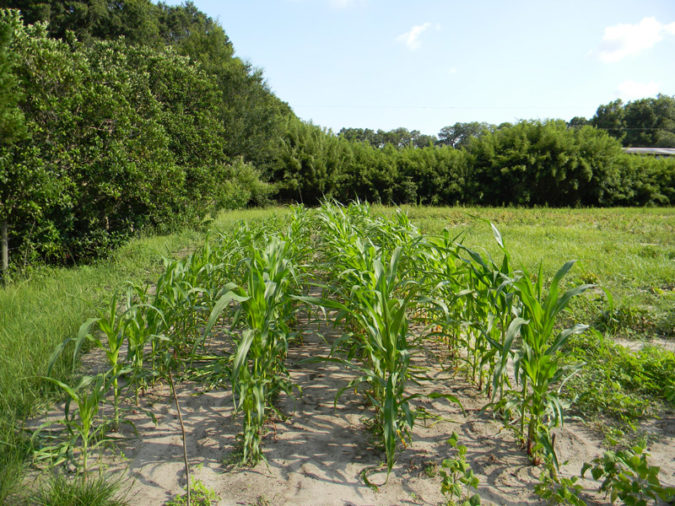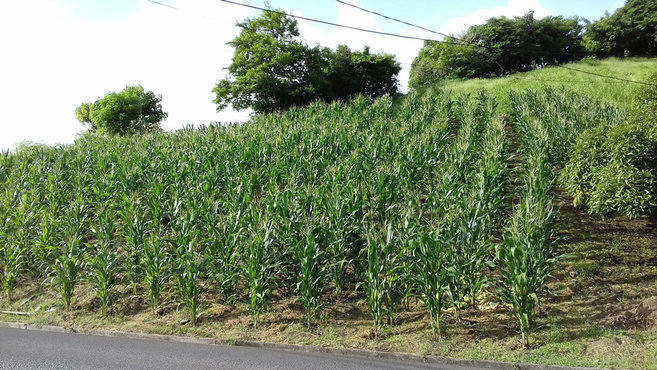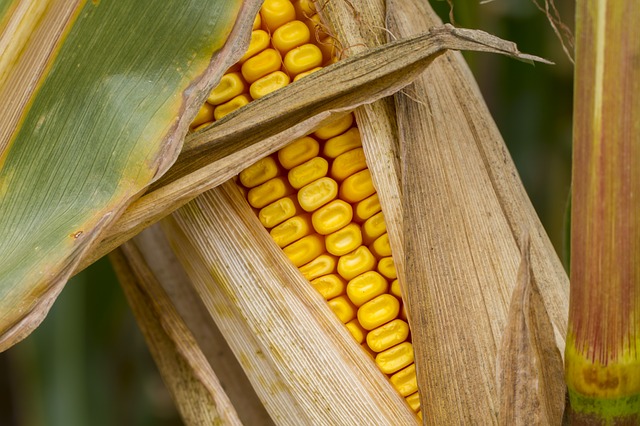Before I moved to Central America a couple of years ago, I always planted corn in rows, one plant every 6-12 inches, 1.5-3 feet apart.
Like this:

Then a farmer taught me the local method of planting corn in stations, and I’ve found it really saves prep time.
Read More: “Hand Pollinating Corn for Seed Saving”
Instead of tilling an area, you just take a string trimmer (or scythe or whatever may be your weed-clearing weapon of choice) and scalp the ground right down to the dirt.
Then knock loose holes in the ground about 2.5 feet apart, plant 4 kernels in each hole, and feed with manure or whatever high-nitrogen material you have.
In a few weeks, the corn will grow taller, but the weeds you knocked down will also return. Come back with your string trimmer and knock all the space between the corn back to bare earth.
In a few more weeks, the corn will be tall enough to take care of itself and shade out the weeds. Eventually, you harvest the ears, then turn the ground over to grow something else.
It’s really an easy system. You can see a patch I planted this way in this video.
This method of planting corn can also be used in a pigeon pea/corn intercrop system like I wrote about here.
As I remark in the video, I’d really love to try this in a typical lawn. Imagine doing this in the midst of an expanse of St. Augustine or bahia! What great fun.
Here’s a large patch of corn growing this way:

See how it was done? It’s the same method of hacking holes into the soil and planting kernels. 3-4 seeds are planted in each hole and the corn grows nicely that way in a small clump. Between clumps is about 2.5 feet in all directions.
This method seems to work very well on slopes, as the roots of the weeds and grass hold the soil together, whereas tilling it all and row planting corn could lead to serious erosion issues.
The harvests are decent as well — I haven’t noticed a drop off in productivity at all. The wider spacing also means you can often grow corn without any irrigation, depending on your climate.
David The Good is a Grow Network Change Maker, a gardening expert, and the author of five books you can find on Amazon: Compost Everything: The Good Guide to Extreme Composting, Grow or Die: The Good Guide to Survival Gardening, Totally Crazy Easy Florida Gardening, Create Your Own Florida Food Forest, and Push the Zone: The Good Guide to Growing Tropical Plants Beyond the Tropics. Find fresh gardening inspiration at his website TheSurvivalGardener.com and be sure to follow his popular YouTube channel.









COMMENTS(8)
What kind of corn does everyone plant? I’m looking for suggestions! Thanks.
I love grain corn varieties. My favorite is Hickory King. If you eat them in the milk stage, they’re better than sweet corn. Not as sugary, but with a rich corn flavor. Let them mature and they make AWESOME grits.
Thanks! I have heard others talk highly of that variety, also, I believe.
Bummed that the kids let our birds out into my garden last year when I was trying something very similar to this. None of that corn survived.
Great video and info. Our soil is pretty rocky here too. I’ll have to try this.
Hi David, great video. I have planted my corn twice already – and so bummed that nothing came up 🙁 So yes, there is real joy when they do. KDT1973 (any chance you could put up a photo of your smiling face – you look great in that shirt!) – I initially planted the corn that came in the SLow FOod Arc of Taste seed kit – the variety name is eluding me at the moment. I don’t hink it was the seed source fault as I biffed it on the watering. Yikes, that happens to me all too often as if you’ve been following my FB live events on Thursdays you know my travel schedule is insane right now.
The second time I planted it was Rio Grand Red which I’ve had some wonderfull success. But I kind of con’t like it because it grows 12′ tall and tends to blow down in my garden.
I am thinking of planting painted mountian in a garden I am starting in Colorado. It is a short fast variety developed for high climate, northern regions.
wow, my spelling is atrocious! Forgive me 🙂
Great idea! We had a problem during a storm our tall stalks blew over and we lost it all one year. Any suggestions on how to ensure that when we plant, or stalks don’t fall again?